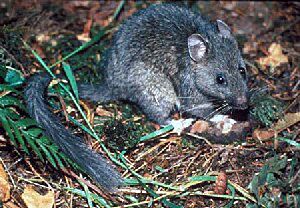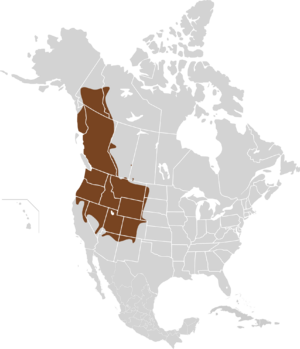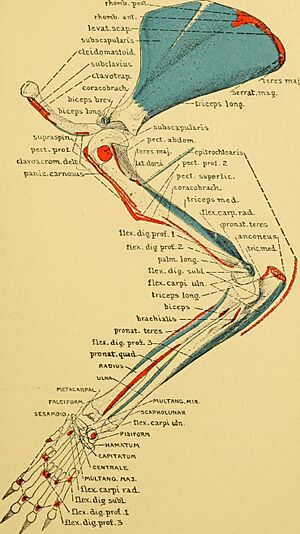Bushy-tailed woodrat facts for kids
Quick facts for kids Bushy-tailed woodrat |
|
|---|---|
 |
|
| Conservation status | |
| Scientific classification | |
| Genus: |
Neotoma
|
| Species: |
cinerea
|
 |
|
The bushy-tailed woodrat is a type of rodent found in Canada and the United States. People also call it a packrat. It lives in many places, like cold forests, warm forests, dry grasslands, and areas with shrubs.
This animal is famous for being the original 'pack rat'. It loves to collect things, especially shiny objects! A woodrat might even drop something it's carrying if it sees a coin or a spoon it likes better.
Contents
What Does a Bushy-tailed Woodrat Look Like?
Bushy-tailed woodrats are easy to spot because of their big, round ears and long, bushy tails. Their fur is usually brown with some black hairs mixed in, and their bellies and feet are white. The brown color can change from light tan to almost black. Their tail looks a lot like a squirrel's tail – it's bushy and flat from top to bottom.
These woodrats are great climbers and have very sharp claws. They use their long tails to help them balance when they climb and jump. Their tails also help keep them warm.
Male woodrats are usually about 50% bigger than females. An adult woodrat can be about 28 to 46 centimeters (11 to 18 inches) long, and half of that length is just its tail! They weigh around 590 grams (1.3 pounds). The bushy-tailed woodrat is the largest type of woodrat and can handle cold weather better than others.
Where Do Bushy-tailed Woodrats Live?
Bushy-tailed woodrats live in western North America. You can find them from the arctic parts of Canada all the way down to northern Arizona and New Mexico. They also live as far east as the western parts of North and South Dakota and Nebraska.
What Kind of Homes Do They Like?
Bushy-tailed woodrats live in many different places, from cold boreal forests to dry deserts. They especially like rocky areas, so you often find them near cliffs, canyons, rocky slopes, and open fields with rocks. They can also make homes in old buildings and abandoned mines.
They can live from sea level up to 4,267 meters (14,000 feet) high. However, in the southern parts of their range, they tend to stick to higher places. These woodrats don't do as well in very old forests. They are more common and live in larger numbers in more open areas.
What Do Bushy-tailed Woodrats Eat?
Bushy-tailed woodrats prefer to eat green plants like leaves, needles, and new shoots. But they also eat twigs, fruits, nuts, seeds, mushrooms, and even some small animals. A study in southeastern Idaho found that they eat grasses, cactus, vetch, sagebrush, and mustard plants. They also eat a few arthropods (like insects). In dry places, they focus on eating succulent plants, which hold a lot of water.
These rodents get most of the water they need from the plants they eat.
Reproduction and Life Cycle of the Woodrat
Male woodrats show who is in charge of their area by leaving their scent and sometimes by fighting. These fights often involve biting and scratching, which can cause serious injuries.
Woodrats usually have babies in the spring and summer, from May to August. The mother is pregnant for about five weeks. A female can have one or two groups of babies (litters) each year. A litter can have two to six babies, but usually, there are three. Females only have four mammary glands (for nursing), so if they have more babies, some might not survive. Females have even been seen getting pregnant again just 12 hours after giving birth, meaning they can be pregnant with one litter while still nursing another!
In zoos, babies are born after 27 to 32 days. Newborns weigh about 15 grams (0.5 ounces). Their eyes open when they are about 15 days old, and they stop drinking milk from their mother at 26 to 30 days old.
Male babies leave their mother when they are about 2½ months old. Female babies often stay close to their mother, sometimes even sharing the same living area. This is unusual because woodrats are very territorial. Scientists are still trying to understand why this happens. Daughters might share food with their mother, which helps them survive. Also, having more females in an area might help attract males.
Female woodrats usually have their first babies when they are one year old.
How Do Bushy-tailed Woodrats Behave?
Bushy-tailed woodrats are active all year long. They are mostly active at night (this is called nocturnal), but sometimes you can see them during the day. They usually live alone and are very protective of their territory.
These woodrats collect things like plant material, feces (poop), and other items. They build large piles of these materials in natural cracks in rocks or in old human-made structures. These piles are called 'middens'. The woodrats' urine helps to solidify these middens. Their urine has a lot of calcium from the succulent plants they eat.
It's important to know the difference between a midden and a nest. A nest is where the animal actually lives and where females raise their young. Nests are usually inside the midden, but this can be different in some areas. If the nest isn't inside the midden, it's often hidden in a rocky crack behind a barrier of sticks.
In coniferous forests (forests with pine trees), a woodrat might build its house as high as 15 meters (50 feet) up a tree!
Bushy-tailed woodrats do not hibernate (sleep through the winter). Instead, they build several places to store food, which they use during the colder months.
When a bushy-tailed woodrat is scared, it will drum its hind feet on the ground. It also drums its feet when it's not scared, making a slow, tapping sound.
Who Hunts Bushy-tailed Woodrats?
Many animals hunt bushy-tailed woodrats, including: spotted owls, bobcats, black bears, coyotes, foxes, weasels, Snakes, martens, and hawks. The safe, sheltered conditions inside a woodrat's midden are often used by reptiles during colder months. For example, the rattlesnake, which usually hunts woodrats in warmer weather, often stays in their middens.



